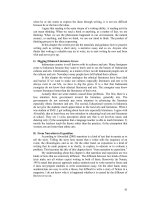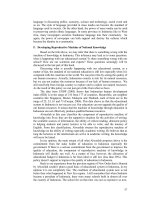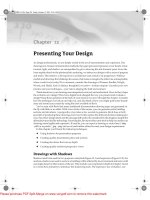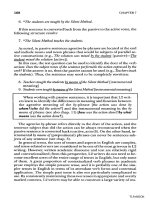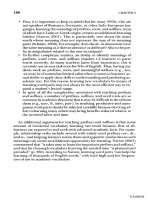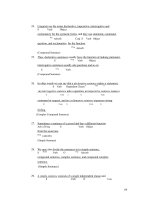Tài liệu Teaching and learning english part 13 ppt
Bạn đang xem bản rút gọn của tài liệu. Xem và tải ngay bản đầy đủ của tài liệu tại đây (405.8 KB, 7 trang )
85
B. The Review on the Research Article
Jung, (2001) states that Pragmatic is a subject that is indispensable part of
language learning. It has received insufficient attention in acquisition but the
question is how to go from recognizing the importance of the issue to moving into
classroom language learning and mitigating cross-cultural communication failure.
Therefore, Bouton (1996) cited by Rasekh, states that the development of
communicative competence should be the goal of language teaching. It is believed
that there is possibility of teaching pragmatics in an EFL setting with the assumption
that the problems of pragmatic failure can be overcome by giving the students the
tools to make the processes of pragmatic decision-making explicit.
Regarding the importance of the pragmatic competence to the learners, I find
this research very useful and interesting to discuss. In this case, I don’t want to
review on the form and the methodology of the research, but I am going to concern
with the results and the ideas. There are some comments I would like to share:
The first, I agree that teaching pragmatics in an EFL setting is necessary and
teachable. Kasper (1997), argues that pragmatic is needed to be taught in an EFL
classroom setting. He suggests students should be provided with opportunities to
develop their pragmatic competence. In this case, teaching of pragmatics aims to
facilitate the learners' ability to find socially appropriate language for the situations
they encounter. Furthermore, Wildner-Bassett and Tateyama in Bardovi-Harlig
(1997) have demonstrated that pragmatic routines are teachable to beginning foreign
language learners. This experience important in terms of curriculum and syllabus
design because it dispels the myth that pragmatics can only be taught after students
have developed a solid foundation in L2 grammar and vocabulary. Just as in
uninstructed acquisition, students can start out by learning pragmatic routines which
they cannot yet analyze but which help them cope with recurrent, standardized
communicative events right from the beginning.
The second, comparing the relative effect of explicit and implicit instruction,
in line with the writer, the students' pragmatic abilities improved regardless of the
adopted approach, but the explicitly taught students did better than the implicit
groups. Thomas (1995) states that an explicit performative can be seen to be a
mechanism which allow the speaker to remove any possibility of misunderstanding
behind an utterance. As a matter of fact, a number of researchers have explored the
role of instruction in learners’ pragmatic development. Indeed, different language
owes different cultures. Automatically, each of them has different way in greeting,
inviting, apologizing, even opening and closing a conversation. These differences
demand a great effort of teachers to expose as well as to employ the real use of
certain expression at certain situation. Based on the result of the research, explicit
metapragmatic instruction facilitates interlanguage pragmatic development and
reveals that pragmatic competence does not seem resistant to explicit metapragmatic
instruction. Te assumption is that the problems of pragmatic failures can be
overcome by giving the students the tools to make the processes of pragmatic
decision-making explicit.
The third, I agree if exposing learners to pragmatics in their foreign language
is needed since it helps the learners to expand their perception of the target language
and those who speak it. Peirce (1995) cited by Kasper, noted that language
classrooms provide an ideal arena for exploring the relationship between learners'
subjectivity and L2 use. Classrooms afford second language learners the opportunity
86
to reflect on their communicative encounters and to experiment with different
pragmatic options. In this case, the goal of instruction in pragmatics is not to insist
on conformity to a particular target-language norm, but rather to help learners
become familiar with the range of pragmatic devices and practices in the target
language. With such instruction, learners can maintain their own cultural identities,
participate more fully in target language communication, and gain control of the
force and outcome of their contributions. Instruction should allow students to
choose how much of the pragmatic norms of the culture they would like to include
in their own repertoire. As a result of the activities suggested, they will be better
able to interpret the speech of others and, therefore, to decide what they feel
comfortable adopting. They will also enjoy greater insights into the target culture.
At last, this research have given contribution and input on the application of
pragmatic to EFL teaching. It is hoped, the problems of pragmatic failures can be
overcome and the learners can figure out the norms of appropriateness for various
speech acts and different interlocutors in the target culture
C. Conclusion
In line with the researcher, based on the result of the research, the main point
we have to consider is that teaching pragmatics in an EFL setting is necessary and
teachable. Comparing the relative effect of explicit and implicit instruction, the
students' pragmatic abilities improved regardless of the adopted approach, but the
explicitly taught students did better than the implicit groups.
Exposing learners to pragmatics in their foreign language is needed since it
helps the learners to expand their perception of the target language and those who
speak. Therefore, the problems of pragmatic failures can be overcome and the
learners can figure out the norms of appropriateness for various speech acts and
different interlocutors in the target culture
References
Jung, J. Y. (2001). Issues in Acquisitional Pragmatics. Working paper in TESOL
and applied linguistics, Teacher's College, Columbia University.
Kasper, Gabriele. (2001).
Classroom Research on Interlanguage Pragmatics. In K.
Rose & G. Kasper (Eds.), Pragmatics in language teaching. Cambridge:
Cambridge University Press.
Kasper, Gabriele. (1997).
Can Pragmatic Competence Be Taught? (online)
/>.
Rasekh et.al (2004)
The Effect of Explicit Metapragmatic Instruction on the Speech
Act Awareness of Advanced EFL Students.
(online) to-
su.ac.jp/information/tesl-ej/ej30/a3.html. [March 17
th
2007]
Thomas, Jenny. (1995)
Meaning in Interaction. London and New York: Longman
Wildner-Bassett and Tateyama in Bardovi-Harlig (1997)
Teaching Pragmatic
(online) intro. htm
87
STUDENTS’ VOCABULARY LEARNING STRATEGIES
Aisyah
A. Background
Having been an English teacher of a-third year students for several years lead
me to be in stress facing the students’ failure of using English as a means of
communication. Then, I figure out one of the factors bringing to the unsuccessful
phenomenon could be the students’ lack of vocabulary. The existence of vocabulary is
very important in language learning. It is one of the vital elements in constructing
meaningful communication. It can’t be imagined how learners can speak and write well
if they do not possess the words needed to convey their ideas and feelings. A student
who masters a good structure seems to lose its function whenever it is not supported by
the abundance of words. Even, reading and writing become meaningless without that
words mastery. As Davis in Abdullah (ETF) claims that the factor that correlated most
highly with comprehension is knowledge of word meaning. It means that learning
vocabulary as one of the components in linguistic competence (KTSP) is very essential
for language acquisition, whether first, second or foreign (Far, 2006).
For some extend, vocabulary may become the important elements in all skills of
language. It is likely a soul of building oral communication. Richards (2000) states that:
Vocabulary and lexical units are at the heart of learning and communication. No amount
of grammatical or other type of linguistic knowledge can be employed in communication
or discourse without the mediation of vocabulary. Indeed, vocabulary and lexical
expressions can sustain a great deal of rudimentary communication without much support
from other aspects of the language system. Understanding of the nature and significance
of vocabulary knowledge in a second language therefore needs to play a much more
central role in the knowledge base of language teachers.
This is also supported by Rivers (cited in Nunan, 1991:117) that vocabulary is essential
for successful second language use because without an extensive vocabulary we will be
unable to use the structures and functions we may have learned for comprehensible
communication. As a teacher I have experienced that in the classroom the learners who
had mastered the English structures and functions, but lack of vocabulary, found
difficulty to use them in communicative interaction. In other words, it can be said that
no matter how well students learn grammar and sounds of words, without words to
express wide range of meanings, communication will become meaningless.
Vocabulary also takes important part in written communication, reading and
writing. To comprehend the texts as well as to express their ideas and feelings, the
students require a wide amount of vocabulary. As Sheehan (English Teaching Forum,
vol. 42) informs that evidence suggests language learners need to learn as many words
as possible as soon as possible (initial 2000 word target, with 10,000 words as an ideal
longer-term target). It indicates that the vocabulary mastery is an urgent need since the
limited words will make the students’ understanding of a text become narrow and their
writing also may lose its soul. Meara (1995) points out that knowing only 500 words is
functionally useless. English learners with such a minimal vocabulary who try to
process a text will encounter too many unfamiliar words, and frequently these are
precisely the words that convey the meaning of the text. The fact in English class shows
that most of students have to face trouble in comprehending the text because of the
88
unknown words. Such problem happens to the students’ writing, too. That minimal
vocabulary leads them to live in the stressful situation of expressing their ideas.
In order to avoid misunderstanding in oral and written communication, the
students require strategies to know and to use a word. McCarthy (1984) confirms that
the purpose of vocabulary learning should include both remembering words and the
ability to use them automatically in a wide range of language contexts when the need
arises. It reveals that vocabulary learning demands conscious learning mechanism. The
awareness that students employ in learning affects their strategies to memorize the
words, at the end use them in real world.
To assist students’ success of learning, many experts and practitioners conduct
researches. Some studies into the area of language had committed a movement from a
predominantly teaching oriented perspective to one which included interest in how the
actions of learners might affect their acquisition of language. This naturally led to a
greater interest in how learners approached and controlled their own learning and use of
language (Smith, 1997:200). At first, the emphasis was on the identification of
beneficial language strategies (i.e. Stern, 1975; Rubin, 1975; Naiman
et al., 1978;
O’Malley
et al., 1985). Then, it moved to the attempting of varied strategies, which they
developed a categorization framework The well-known scholars in pioneering that field
are Wenden and Rubin, 1987; O'Malley
et al., 1985; Oxford, 1990; Stern, 1992; Ellis,
1994 (see Williams; 2006).
In line with how the learners learn vocabulary, more studies have appeared on
the various aspects of the learning words. Mercer (ETF, vol. 43, 2) focuses her study on
the teaching vocabulary by utilizing consolidation strategies. Her idea is inspired by
Nation (2001) that vocabulary learning can be enhanced when the learners’ attention is
directed consciously to vocabulary items or strategies. Another research on vocabulary
learning strategies is also implemented by Gu (2004). The other the most important
study is that conducted by Schmitt (1997) in which he proposes the taxonomy of
learning strategies used in learning vocabulary. This indicates that vocabulary has
attracted the scholars’ attention, regarding with the assumption of the important
existence of which in students learning.
Regarding with the students’ fail of mastering the amount of vocabulary, I
wonder how students employ their strategies in learning words inside and outside.
Students may endeavor varied strategies for learning words. One may use memorization
as his/her strategy of learning, while the others may utilize many strategies, like
repetition, visual aids, and physical action. However, from the range of vocabulary
learning studies conducted, there is few focusing on the vocabulary learning strategies.
That reason leads my interest in doing this study of exploring the vocabulary learning
strategies employed by the eleventh grade students of MAN 3 Palembang.
2. Aims of the Study
The study will be conducted to seek for the following:
1. to explore vocabulary learning strategies mostly used by the students.
2. to identify the obstacles the students encounter in learning vocabulary.
3. to find out the relationship between the students’ vocabulary learning strategies and
their vocabulary achievement.
3. Questions of the Research
Related to the above purposes, this study proposes the following questions:
1. What are the vocabulary learning strategies mostly used by the eleventh
grade students at MAN 3 in Palembang?
89
2. What are the obstacles the students encounter in learning vocabulary?
3. What is the relationship between the students’ vocabulary learning
strategies and their vocabulary achievement?
B. METHODOLOGY OF RESEARCH
1. Interpretive Approach
Relevant to the purposes and the research questions above, this study will
employ a case study. The case study is chosen in order to describe deeply the real
learning strategies used by the students during their period of learning English
vocabulary. It will be supported by the use of multiple data collection.
Participants
The subjects of this study will be the twelfth graders of MAN 3 Palembang..
They will be selected randomly to represent their classes. It will involve 30 participants.
Since the participants are taken randomly, the researcher assume that amount of subjects
are representative enough. I select this level since I consider they already learn English
quite a long time.
Data Collection Method
Multiple data collection will be employed to obtain rigorous data. Those three
instruments will be:
1. Questionnaire
2. Interview
3. Test
The group-administered questionnaire will be given to the respondents. The
group’s size is thirty as suggested by Oppenheim (1982; 36) since that number of
participants can still be controlled. This instrument will be divided into two sections,
first statements, closed-ended item, used to obtain the data about the strategies of
vocabulary learning mostly employed by the students, second is the open-ended item
which is used to obtain the data about the obstacles encountered by the students.
The interview will be used to obtain data to support and validate the data got
from questionnaire. Nine out of the thirty participants will be selected to be interviewed
that represent the good, the middle, and the poor students.
Finally, the test will be used to get the data of students’ vocabulary achievement.
The vocabulary test will be made based on the text book used. This means that the test
given is reliable with what the students learn so far.
Data Analysis
To analyze the data got from questionnaire, the Lykert scale (never, seldom,
sometimes, often, usually, always) will be used. The data will be categorized and
interpreted to answer research questions number one and two. If it is possible and
necessary the data “will be sent back” (Kvale) to the purpose of ensuring that it is
exactly what the respondents say and mean.
While the data from interview will be analyzed by transcribing them, then
categorizing them using thematic analysis related to the research questions. At last, the
data from interview will be presented in the form of condensed body of information and
interpreted.

